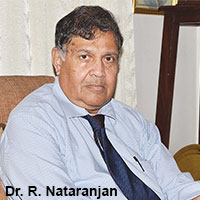Preparing for Education 4.0
 Dr. R. Natarajan is former director of IIT-Madras and former chairman of the All India Council for Technical Education (AICTE)
Dr. R. Natarajan is former director of IIT-Madras and former chairman of the All India Council for Technical Education (AICTE)
The buzzword among educationists today is Education 4.0. To understand Education 4.0, it is important to understand Industrial Revolution (IR) 4.0, which gained traction when a German government memo released in 2013 used the term “Industrie 4.0”. That memo outlined a plan to almost fully computerise manufacturing without need for human intervention.
Industry 4.0 describes the combination of traditional manufacturing and industrial practices with the new all-pervasive digital revolution. The initial goals of Industry 4.0 were automation, improvement of manufacturing processes and production optimisation. However, it’s pertinent to note that the definition of Industry 4.0 is nebulous. Suffice it to say that it goes beyond the factory and beyond automation and data exchange.
To fully appreciate the importance and implication of IR 4.0, a historical perspective is useful. During IR 1.0, water and steam energised production. In the era of IR 2.0, electric power was used to drive mass production. In IR 3.0, electronics and information technology began the process of automating production. Now in the IR 4.0 age, enhancement of IR 3.0 with new digital technologies blurs the lines between the physical, digital and biological worlds. The new technologies evolve at an exponential pace and are hence described as disruptive technologies and include artificial intelligence, robotics, the Internet of things, autonomous vehicles, bio and nanotechnology, 3-D printing, material science, quantum computing and energy storage. IR 4.0 is not only disrupting and revolutionising processes in business, governance and people management, it is impacting education as well.
Hence, Education 4.0 is a response to the needs of IR 4.0, where humans and technologies combine to enable new possibilities. It’s also important to note that in Education 4.0, peer-to-peer learning — students learning together and from each other, with teachers discharging the role of facilitators — is of prime importance.
The defining characteristics of Education 4.0 are:
• Learning can take place anytime anywhere with e-learning apps and pedagogies offering unprecedented opportunities for remote, self-paced learning. Flipped classroom pedagogy will become increasingly popular with interactive learning in classrooms, while theory is learned at home
• Learning is customised for students
• Students determine how they want to learn, choosing from learning tools and pedagogies such as blended learning, flipped classrooms and BYOD (bring your own device)
• Project-based learning will become increasingly popular with students required to apply their knowledge and skills in completing short-term projects
• Students will routinely experience internships, mentorship and collaborative projects
• Students will be exposed to data interpretation, required to apply theoretical knowledge to numbers and use reasoning skills to make inferences based on logic and trends from given sets of data
• Students will be assessed differently, with conventional platforms to assess learning outcomes becoming obsolete or irrelevant. Factual knowledge will be assessed in classrooms, while knowledge application will be tested by way of performance in field projects and assignments
• Students will play a large role in framing syllabi and curriculums
• Students will become more independent with self-study becoming popular and teachers transforming into facilitators
Against this backdrop of students, especially in senior school and tertiary education, assuming greater responsibility for their own education and development, the World Economic Forum has predicted that the new skills required by Education 4.0 will be complex problem-solving, critical thinking, creativity, people management, teamwork and collaboration, emotional intelligence, judgement and decision-making, service orientation, negotiation and cognitive flexibility.
To its credit, the National Education Policy 2019 draft prepared by the nine-member Kasturirangan Committee which is being given its final touches by the Union HRD ministry, recognises that “the policy comes at a time when the Fourth Industrial Revolution is already underway and disruptive technologies such as artificial intelligence have emerged”. The draft broadly endorses the recommendations of the government think tank NITI Aayog, which in a discussion paper (National Strategy for Artificial Intelligence #A1ForAll) highlights the challenges of leveraging artificial intelligence in India. The policy draft also acknowledges other disruptive technologies likely to have a sizeable impact on higher education. One hopes these recommendations aren’t lost in implementation.















Add comment